|
EGYPT |
|---|
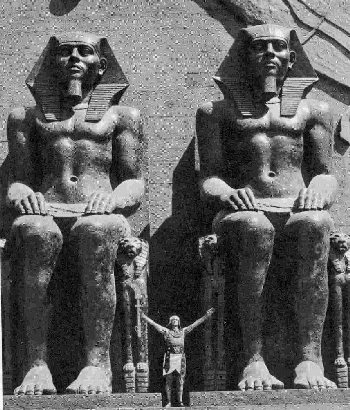
EGYPTIAN MEDICINE -- 2,000 BC
By far the very vast majority of modern day Egyptologists agree that Medical Cannabis (Medical Marihuana) was used by the ancient Egyptians in their medicines. This is in contradiction to what was thought to be the case right up until the early 1930's. In fact, most pre-second world war books dealing with ancient Egypt medicines in general exclude any conversation on the subject.
This discrepancy arose because in the mid 19th Century (when decipherment of the Egyptian language was first made possible) not all of the medicines found in the ancient papyruses were readily identifiable. As Paul Ghalioungui, a senior medical professor at Cairo University writes:[1]
"The papyri contain an extremely rich material medica of which only a fraction has hitherto been identified. This has been done through the patient work of Egyptologists who, by studying finds in graves, hieroglyphic inscriptions where plants figure near their names, and late Coptic texts, have helped considerable in this still unfinished work of identification."Thus, it took awhile (well into the mid 20th Century) until the use of Cannabis could positively be identified and confirmed.
WHAT EGYPTOLOGISTS SAY:
The following is taken directly from a 1934 article by Warren Dawson.[2]
The Journal of Egyptian Archaeology, Vol. 20, No. 1/2. (June 1934), pp. 41-46.
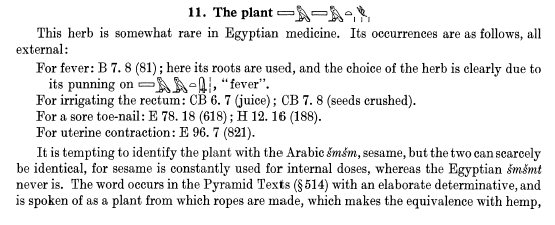

It is of interest to note that Warren Dawsons’ work (pre-W W II) is still being quoted and used today.
According to Lise Manniche [3] (a more modern-day Egyptologists) the following Egyptian hieroglyphs
 reads left to right |
 reads right to left |
|---|
Mention of this medicine is made in the following Egyptian medical texts:
- The Ramesseum III Papyrus (1700 BC) ; British Museum of London - Plate A26
- The Eber’s Papyrus (1600 BC) ; "University of Lepzia" Plates XCVI , LXXVIII
- The Chester-Beatty VI (Medical) Papyrus (1300 BC): (British Museum 10686 sheets 6, 7)
- The Berlin Papyrus (1300 BC) Sheet 7
- The Hearst Papyrus (1,550 BC) ; University of California Berkeley Plate XII
- The Vienna Papyrus 6257 (200 AD) Columns IX and XIV
- And others
THE RAMESSEUM III PAPYRUS (1700 BC)
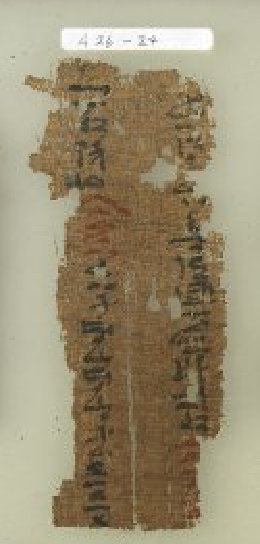
[Selected section - Ramesseum III Papyrus]
[Part of Plate A26 - Courtesy of the "British Museum of London"
Ramesseum III Read from top to bottom

[Click photo for larger image]
As can be seen the Ramesseum III papyrus scroll (that which is still in existence today) actually consists of various bits and pieces. However, (as luck would have it) at least one of the sections that made mention of Medical Cannabis is still very much intact. [see picture].
As most Egyptologists put the date of the scroll at around 1,700 BC, this would make it one of the oldest known medical references on the subject.
THE EBERS PAPYRUS (1500 BC) - PART I
The Ebers papyrus was written over 1,500 years before the birth of Christ, thus making it the oldest known "complete" medical textbook in existence. In addition, many scholars claim that this text is actually a reprint of a much earlier text written or put together years long before before that.
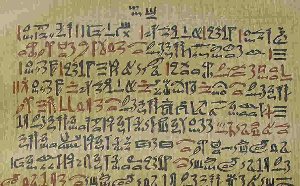
[Selected section - Ebers Papyrus]
[Part of Plate XCVI - Courtesy of the "University of Lepzia"
Formula No. 821 (Location Plate #96, Lines 7-8)

[Click photo for larger image]
Formula No. 821 (96, 7-8)
Interpretation:
Sm-Sm-et (hemp) ground in honey; introduced into her vagina.
[It is of interest to note that hemp seed oil was in used well into the mid 20th Century to treat inflammations - Examples:]
- The 1907 Merck Index (pp.132) lists that use of Cannabis seeds for emulsions to be used to relieve the effects of gonorrhea.
- "Hemp seed, in infusion, has been found very useful in after-pains, and in the bearing down sensation accompanying prolapsus uteri. ---"King's American Dispensatory" 1909;
- "When (hemp seed oil is) rubbed with water form an emulsion, which may be used advantageously in inflammations of the mucous membrane ---1927 "U.S. Dispensatory"
THE EBERS PAPYRUS (1500 BC) - PART II

[Selected section - Ebers Papyrus]
[Part of Plate LXXVIII - Courtesy of the "University of Lepzia"
Formula No. 618 (Plate #78, Lines 10-11)

[Click photo for larger image]
Formula No. 618 (78, 10-11)
Interpretation:
Remedy for a toe-nail (or finger)
Ingredients included honey, ochre smsm-t (hemp) and other ingredients
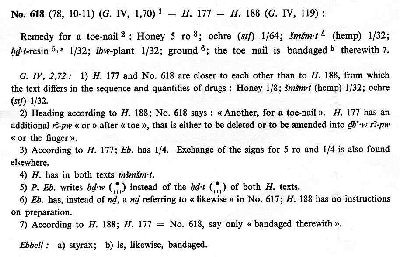
[From the book - Ebers Papyrus by paul Ghalioungui ]
To reiterate, the Ebers Papyrus is NOT the oldest known recorded mention of the medical uses of Cannabis, BUT it is the oldest known "complete" medical textbook in existence. That is what makes it so unique.
Chester-Beatty VI (Medical) Papyrus (1,300 BC): (sheet I)
Medical Cannabis is mentioned at least twice within the Chester Beatty VI (Medical) papyrus scroll. In general, while the papyrus scroll is not complete, those pages that do exist are in very readable condition. Almost all writing is on the Retro side, while the Verso is almost blank. [Estimates assume that the whole scroll (if complete) would measure some 4.4 feet long, 8 inches tall.]
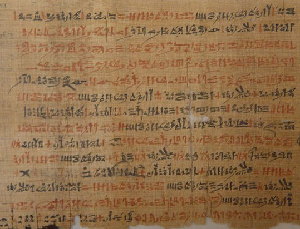
[Selected section - CB-VI (plate 31A -Recto 6, line No. 7]
[British Museum 10686]

[Click photo for larger image]
Chester-Beatty VI (Medical) Papyrus (1,300 BC): (sheet II)
Medical Cannabis is mentioned at least twice within the Chester Beatty VI (Medical) papyrus scroll. In general, while the papyrus scroll is not complete, those pages that do exist are in very readable condition. Almost all writing is on the Retro side, while the Verso is almost blank. [Estimates assume that the whole scroll (if complete) would measure some 4.4 feet long, 8 inches tall.]
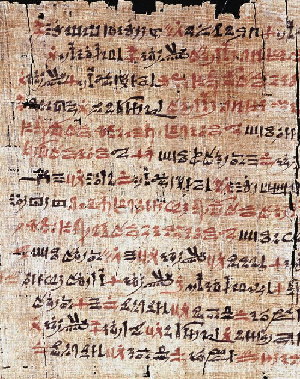
[Part of Plate CB-VI (plate 31A -Recto 7, line No. 8]

[Click photo for larger image]
THE HEARST PAPYRUS
Due to economic reasons (this museum just doesn’t have much $$ ), we were unable to obtain an actual print of the Hearst Medical Papyrus [located at U.C. Berkeley California]. However, the above page from the book “Die Mendizinischen Texte in Hieroglyphischer Umschreibung Autographiert” by Grapow Hermann, shows how similar formulas (H177, H188) contained within the Hearst papyrus are with the one (E618) found within the Ebers medical papyrus.
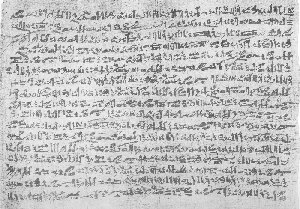
[Hearst Papyrus Plate XII, Lines 7, 16]

[Click photo for larger image]
THE BERLIN PAPYRUS 3038 (1300)
Most Egypt-analogists also set the date of the papyrus at only around 1,300 BC. Thus while far from the oldest known reference to Medical Cannabis, it is interesting to note that here [prescription No. 81] shows that it was being used in an external anti-fever/inflammation ointment.
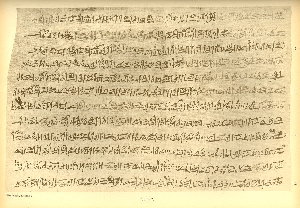
[Selected section - Berlin Papyrus]

[Click photo for larger image]
The above pictures/plates are taken from the 1909 German Language book -- Der grosse medizinische Papyrus des Berliner Museums (Pap. Berl. 3038) in Facsimile und Umschrift By Von Walter Wreszinski
THE VIENNA PAPYRUS 6257 (200 AD)
Although the Vienna medical papyrus was written around 200 AD (and thus not really an ancient Egyptian papyrus) its main importance is that it is actually a composite of ALL other Egyptian medical knowledge from before when.
A considerable number of medical works have been preserved from the Middle and New Kingdom; then, following a gap of many centuries between the 19th Pharaonic dynasty, and the 2nd half of the 2nd century AD)., the date of our papyrus, a period during which this category of scientific sources is scarcely represented by native Egyptian documents, only one complete manuscript can be cited from the Coptic era.
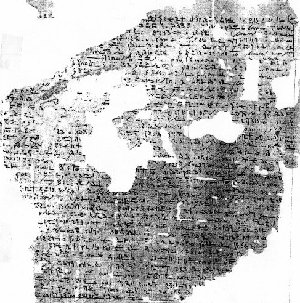
[Selected section - Vienna Papyrus]
[Part of Plate IX - various Cannabis references]

[Click photo for larger image]
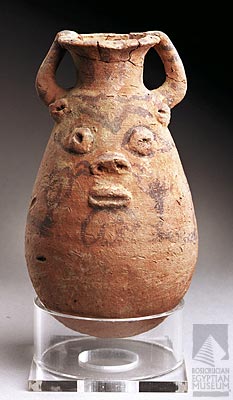
Did this Jar once contain Medical Marihuana?
In all likelyhood, probably YES.
Perhaps one of the first apothecary (medical) jars known. This is a good example of an Egyptian apothecary or medical jar (courtesy of the Rosicrucian Egyptian Museum -- www.egyptianmuseum.org." ). These jars could be the size of a small cup or a large jug and as such could be used to store medicines or simply as a dispenser. The face is that of the God of medicine Bes.
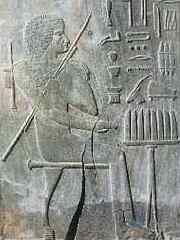
FOOT NOTES:
[1]- From the book "Magic and Medical Science in Ancient Egypt" by Paul Ghalioungu M.D., senior professor of medicine, Ain Shams University, Cairo
[2] - Studies in the Egyptian Medical Texts: III by Warren R. Dawson -- The Journal of Egyptian Archaeology, Vol. 20, No. 1/2. (June 1934), pp. 41-46. The complete text can be found at: http://links.jstor.org/sici?sici=0307-5133%28193406%2920%3A1%2F2%3C41%3ASITEMT%3E2.0.CO%3B2-E
[3]- "An Ancient Egyptian Herbal" by Lise Manniche, published under the auspices of the British Museum of London and the University of Texas. As a side note, Ms. Manniche is acknowledged as being the leading authority on the subject of ancient Egyptian Herbs and medicines by numerous Egyptologists.
[4]- It should be pointed out that the Curator of the Rosicrucian Egyptian Museum pronounces it, "sm-sm-Et."
[5]- Picture of Hesi Re
[http://nefertiti.iwebland.com/timelines/topics/medicine.htm]
Hesi the physician Hesi Re, Physician and scribe ca. 2650 BCE
http://www.highculture.8m.com/HesiRe.html
http://www.13beyond.com/hesy-ra/home.htm This picture was taken off a website, that borrowed it from another website, that borrowed it from a book, that borrowed it from a coffin that . . . .etc. If anyone out there knows who originated it, please let me know as I would like to buy that person a beer.
WANT TO KNOW MORE:
=====================
Due to space / download time considerations, only selected materials are displayed. If you would like to obtain more information, feel free to contact the museum. All our material is available (at cost) on CD-Rom format.
CONTACT PAGE
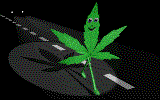 BACK TO CHAPTER 2 |
EGYPT On to the Next Section |